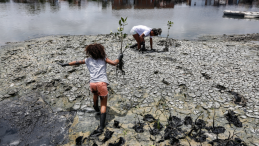On 18 May 2024, UNU-IAS co-organized a side event of the 26th meeting of the Subsidiary Body on Scientific, Technical and Technological Advice (SBSTTA 26) of the Convention on Biological Diversity (CBD) in Nairobi. The event highlighted multi-stakeholder collaboration in implementing landscape approaches for biodiversity conservation and sustainable use.
Opening the session, Wataru Suzuki (Director, Biodiversity Strategy Office, Nature Conservation Bureau, Ministry of the Environment, Japan) emphasized that the Government of Japan and UNU-IAS had been promoting the International Partnership for the Satoyama Initiative (IPSI) since 2010. Maiko Nishi (Research Fellow, UNU-IAS) explained the mission of IPSI — to promote sustainable management of natural resources through landscape approaches to safeguard biodiversity and livelihoods. Jamal Annagylyjova (Forest Biodiversity Officer, CBD Secretariat) noted that landscape approaches have the potential to bring the transformative change needed to achieve the Biodiversity Plan.
The event shared case studies featured in the upcoming UNU-IAS book Business and Biodiversity: Reciprocal Connections in the Context of Socio-ecological Production Landscapes and Seascapes (SEPLS). Lika Sasaki (Programme Management Office for BioTrade Initiative, UN Trade and Development) discussed Siam benzoin gum in Viet Nam, an aromatic resin, which supports local communities and biodiversity while serving the global perfume industry. Florence Mayocyoc-Daguitan (Indigenous Peoples and Biodiversity Program, Tebtebba) introduced the Pidlisan Tribe’s agroprocessing enterprise in the Philippines, which uses traditional knowledge to increases biodiversity in the soil to enhance agricultural lands. Emilio R. Díaz-Varela (Associate Professor, University of Santiago de Compostela) presented a study highlighting the critical role of traditional sweet chestnut orchards in promoting sustainable development in Galicia, Spain.The case studies illustrated the need for integrated management strategies to balance modern and traditional practices for maintaining ecological and economic stability.
Suneetha Subramanian (Research Fellow, UNU-IAS) announced that UNU-IAS would revise the Indicators of Resilience in Socio-ecological Production Landscapes (SEPLS), a toolkit enabling communities to self-assess, plan, strategize and monitor their socio-ecological resilience. The revisions will align with the targets of the Biodiversity Plan and aim to inspire local discussions on biodiversity and sustainability.
Panel discussion on landscape approaches featured gender, youth, and national government perspectives. Irene Natukunda (Global Youth Biodiversity Network, Uganda) stressed the importance of ensuring that scientific content is well understood by all, including youth. Hideki Kawai (Deputy Director of Biodiversity Strategy Office, Nature Conservation Bureau, MOEJ) discussed the challenges of stakeholder identification in implementing landscape approaches in Japan, emphasizing the need for inclusive collaboration.
The event was co-organized by UNU-IAS, IPSI, the Ministry of the Environment, Japan (MOEJ), the Global Youth Biodiversity Network (GYBN), and the Forest Peoples Programme (FPP).


